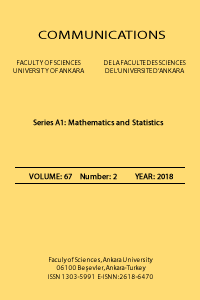Meta fuzzy index functions
___
- Alvarez-Plata, P. and Schrooten, M., The Argentinean Currency Crisis: A Markov Switching Model Estimation, The Developing Economies, XLIV-1 (2006), 79-91.
- Ari, A. and Cergibozan, R. , A Comparison of Currency Crisis Dating Methods: Turkey 1990-2014, Montenegrin Journal of Economics, 12(3) (2016), 19-37.
- Bezdek, J.C., Ehrlich, R. and Full, W., FCM: The fuzzy c-means clustering algorithm, Computers and Geosciences, 10(2-3) (1984), 191-203.
- Bussiere, M. and Fratzscher, M., Towards a new early warning system of financial crises, Journal of International Money and Finance, 25(6) (2006), 953-973.
- Boyles, R.A., The Taguchi capability index, Journal of Quality Technology, 23(3) (1994), 615-643.
- Bunda, I. and CaZorzi, M., Signals from housing and lending booms, Emerging Markets Review, 11(1) (2010), 1-20.
- Chan, L.K., Cheng, S.W., and Spriring FA , A new measure of process capability, Journal of Quality Technology, 20(3) (1988), 162-175.
- Chen, K.S., Pearn, W.L. and Lin, P.C., A new generalization of the capability index Cm for asymmetric tolerances, International Journal of Reliability, Quality and Safety Engineering, 6(4) (1999), 383-398.
- Clements, J.A., Process capability calculations for non-normal distributions, Quality Progress, September, (1989), 95-100.
- Corsetti, G., Pesenti, P., and Roubini, N., What caused the Asian currency and financial crisis?, Japan and the World Economy, 11 (1999), 305-373.
- Corsetti, G., Pesenti, P., and Roubini, N., Fundamental determinants of the Asian crisis: The role of financial fragility and external imbalances, Regional and Global Capital Flows: Macroeconomic Causes and Consequences, 10 (2001), 11-41.
- DerSimonian, R. and Laird, N., Meta-analysis in clinical trials, Controlled Clinical Trials, 3 (1986), 177-188.
- Dunn, J.C., A fuzzy relative of the ISODATA process and its use in detecting compact well-separated clusters, Journal of Cybernetics, 3(3) (1973), 32-57.
- Efron, B., Bootstrap methods: another look at the jackknife, In Breakthroughs in statistics (pp. 569-593). Springer, New York, NY 1992.
- Eichengreen, B., Rose, A.K., and Wyplosz, C., Contagious currency crises, Scandinavian Journal of Economics, 98(4) (1996), 463-484.
- Glass, G.V., Primary, secondary, and meta-analysis of research, Educational researcher, 5(10) (1976), 3-8.
- Johansen, S., Statistical Analysis of Cointegration Vectors, Journal of Economic Dynamics and Control, 12(2-3) (1988), 231-254.
- Kaminsky, G., Lizondo, S. and Reinhart, C.M., Leading Indicators of Currency Crises, IMF Staff Papers, 5(1), (1998) 1-48.
- Kane, V.E., Process capability indices, Journal of Quality Technology, 18(1) (1986), 41-52.
- Krishnapuram, R. and Keller, J.M., A possibilistic approach to clustering, IEEE Transactions on Fuzzy Systems,1(2) (1993), 98-110.
- Krkoska, L., Assessing macroeconomic vulnerability in central Europe, European Bank for Reconstruction and Development ,Working paper, 52 (2000).
- Pal, N.R., Pal, K., Keller, J.M. and Bezdek, J.C., A possibilistic fuzzy c-means clustering algorithm, IEEE Transactions on Fuzzy Systems, 13(4) (2005), 517-530.
- Pearn, W.L. and Chen, K.S., Estimating process capability indices for non-normal Pearsonian populations, Quality and Reliability Engineering International, 11(5) (1995), 386-388.
- Pearn, W.L. and Chen, K.S., Capability indices for non-normal distributions with an application in electrolytic capacitor manufacturing, Microelectronics and Reliability, 37(12) (1997), 1853-1858.
- Pearn, W.L. and Kotz, S., Encyclopedia and Handbook of Process Capability Indices A Comprehensive Exposition Of Quality Control Measures, Singapore: World Scientific Publishing Co. Pte. Ltd. 2006.
- Sullivan, L.P., Reducing Variability: A New Approach to Quality, Quality Progress, 17(7) (1984), 15-21.
- Türkiye Cumhuriyet Merkez Bankası (TCMB), https://evds2.tcmb.gov.tr/index.php?/ evds/serieMarket/ (accessed 12.09.207)
- Wright, P.A., A process capability index sensitive to skewness, Journal of Statistical Computation and Simulation, 52 (1995), 195-203.
- Von Hagen, J. and Ho, T., Twin Crises: A Reexamination of Empirical Links, Center for European Integration Studies, University of Bonn, 2003.
- Yalçın, E.C., Süreç verilerinin normal dağılışa uymadığı durumlarda kullanılan süreç yetenek analizi yöntemleri üzerine bir araştırma, Doktora Tezi, Dokuz Eylül University.
- Yiu, M.S., Ho, A. and Jin, L., Econometric Approach to Early Warnings of Vulnerability in The Banking System and Currency Markets for Hong Kong and Other EMEAP Economies, Hong Kong Monetary Authority, Working Paper, 8 (2009).
- Zadeh, L.A., Fuzzy sets, Information and control, 8(3) (1965), 338-353.
- ISSN: 1303-5991
- Yayın Aralığı: Yılda 4 Sayı
- Başlangıç: 1948
- Yayıncı: Ankara Üniversitesi
Selcen YÜKSEL PERKTAŞ, Feyza Esra ERDOĞAN
Abdulhamit KÜÇÜKASLAN, Vagif S. GULİYEV, Ayhan SERBETCİ
Yasin ÜNLÜTÜRK, Rashad ABDEL-BAKY
Fatih KUTLU, Feride TUĞRUL, Mehmet ÇİTİL
İsmail EKİNCİOĞLU, Esra KAYA, Şeyma EKİNCİOGLU
Orhan KESEMEN, Eda ÖZKUL, Ülkü ÜNSAL
